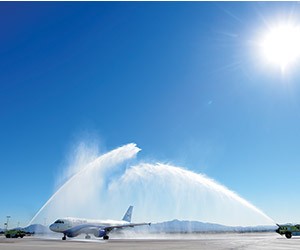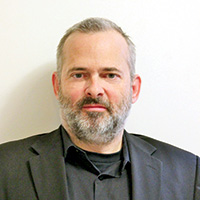Amid the exuberance of record-breaking convention growth, booming revenues and the singular experience that is Las Vegas, there is the serious matter of operations and infrastructure.
Along with the approximately 262,300 front-line and back-of-house workers providing the choreographed service and maintenance that sets Las Vegas apart, the stagecraft also critically depends on three primary functional areas: safety and security operations, transportation options, and on the utility front, water conservation efforts.
Las Vegas may seem like a desert mirage, but its very existence and future relies on unyielding and exacting attention to these real-world concerns, without which there are no milestones or memories.
Secure Assets
Speaking at the U.S. Travel Association’s inaugural Secure Tourism Summit in New York City this April, Jeremy Handel, the LVCVA’s senior director of communications, made this succinct comment: “Before the sales and marketing, you have to make sure the destination is safe and secure.”
Doing just that is Ray Suppe, the bureau’s executive director of customer safety. Participating in a panel discussion at the event on crisis planning and readiness, Suppe, who has overseen all security for the Las Vegas Convention Center (LVCC) for the past 25 years, shared insights into the destination’s ever-vigilant security measures.
Pillars of the system include strong public-private partnerships, open communication and a high degree of security professionalism.
“Las Vegas’ relative small size allows for close working relationships among our key partners,” Suppe said. “These include the Las Vegas Security Chiefs Association; Southern Nevada Counter-Terrorism Center, or Fusion Center; and Las Vegas Metropolitan Police Department (LVMPD).”
Formed in 1987, the association, with 7,000-plus members, comprises resort and casino security directors from across Las Vegas and Southern Nevada, plus representatives from public safety agencies around the community.
“We talk daily and meet monthly,” said Suppe, who serves as secretary for the Security Chiefs Association. “It’s all about security communication, partnerships and training.”
Unique to Las Vegas, the multi-agency Fusion Center includes an intelligence analyst, funded by the LVCC, dedicated solely to the resort community. With its own substation on the LVCC campus, the LVMPD polices and secures the Strip, and stays in real-time communication with the other entities when incidents develop.
The relationship-building extends to customers.
“The LVCC has 5,500 doors, which presents a unique challenge,” he said. “Accordingly, we invest significant time and energy in security planning. For CES and other major events, the conversation takes place year-round.”
“Planning, preparation and practice” were dominant themes at the Secure Tourism Summit, around creating “muscle memory” for responding to any crisis, from terrorism to pandemics to natural disasters. In other words, don’t stick your plan on the shelf to collect dust.
“Recently, a shooting on the Strip sent people running into one local casino,” Suppe said. “Coming off active shooter training, the staff handled the situation without further incident. The culture of awareness and readiness is embedded in the destination.”
Crisis management is among multiple topics on the program this month as the LVCC hosts its 24th annual International Tourism Safety Conference.
Transporting Ideas
Another major group in-bound this summer is the 22nd annual Boyd Group International Aviation Forecast Summit. Returning to Las Vegas following record-breaking editions in 2014 and 2015, the late August event at Wynn Las Vegas will once again feature global aviation CEOs and leaders discussing emerging transportation trends.
PageBreak
“Las Vegas and its airport, McCarran International, are emerging as the leaders in transportation and travel thought-leadership,” stated Michael Boyd, president of the preeminent Colorado-based aviation consulting firm, in a release. “The event is focused on futurist thinking, and Las Vegas is the perfect venue to encourage new perceptions.”
With 30 airlines providing nonstop service to more than 140 destinations, McCarran served north of 47 million arriving and departing passengers in 2016, of which nearly 3.6 million were international travelers. Now welcoming Terminal 1 visitors with a giant in-floor artwork installation featuring Vegas landmarks past and present, McCarran expanded its global reach last year with new and expanded nonstop service from carriers including China’s Hainan Airlines, Norwegian Air and Mexico-based Interjet.
With continuing year-on-year business and leisure market growth, plus the drive for more international visitation, McCarran, now the nation’s eighth busiest in total passenger traffic, is critical to the destination’s ongoing success.
As convention and visitor numbers rise, so does congestion in town. Already underway is Project Neon, or the “Big Squeeze,’ widening 3.7 miles of I-15 between Sahara Avenue and Downtown’s “Spaghetti Bowl” interchange. Other projects on the table include the much-discussed high-speed rail link between Las Vegas and Southern California, and extension of the Las Vegas Monorail.
Liquid Refreshments
Creating a global convention and entertainment destination in the Mojave Desert is one feat. Keeping it “watered” is another.
Take one property alone, such as 4,004-room ARIA Resort and Casino, and think about the round-the-clock demands imposed by all those showers, sinks, toilets and HVAC units. Now factor out nearly 150,000 hotel rooms; some 11 million square feet of meeting space; hundreds of restaurants, bars and other businesses; resort pools; golf courses; and water features, including the famed Fountains of Bellagio.
How can the beleaguered Colorado River, supplying 40 million people in seven states and Mexico, keep up? And, how does Southern Nevada, getting 90 percent of its drinking water from the river via Lake Mead (the rest from pumped groundwater), survive on its 2 percent, or 97.8 million-gallon annual allocation?
The answer starts with the surprising fact that Las Vegas resorts consume only around 7 percent to 8 percent of the city’s water (most consumption is by households), with destination-wide safeguards and conservation measures including computer-aided technology, astute management, recycling systems and cutting-edge sustainability solutions. Part of CityCenter, the world’s largest sustainable development, LEED Gold-certified ARIA features water-saving fixtures that save some 31 million gallons each year.
That’s a common story across MGM Resorts International’s portfolio (with comparable measures on the energy front) and at other major operators including Caesars.
With water management part of its Code-Green initiative, 97 percent of Caesars’ North American properties carry the Global Sustainable Tourism Council’s 4 Green Key-rating, leading the global casino-entertainment industry.
Steve Wynn’s $1.5 billion Paradise Park will replace his existing 18-hole golf course with a 20-acre lagoon for swimming and other aquatic recreation. If this sounds environmentally inconceivable, even reckless, think again—the pool, smaller than the course it is replacing, will reportedly require 30 times less water than a regular 18-hole golf course. Other cutting-edge systems will significantly reduce chemical and energy use in keeping the water clean.
Water reduction features such as turf grass and high-efficiency toilets at LEED Gold-certified Wynn Las Vegas and sibling Encore have helped Wynn Resorts earn recognition as one of the nation’s top green companies.
In Vegas, water is lifeblood, and groups can go to the source at Springs Preserve. Celebrating its 10th anniversary this year as a public venue, this 180-acre campus of gardens, museums, LEED Platinum buildings and event space just west of Downtown is centered around the ancient springs (dried up in 1962) that long supplied the future Vegas. Managed by the Las Vegas Valley Water District, this national landmark is a wellspring of inspiration, including critical reminders and lessons for the future.







